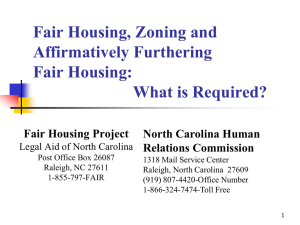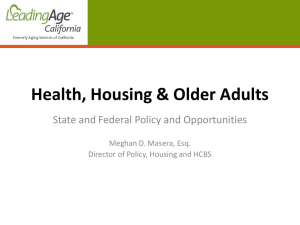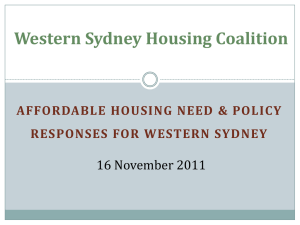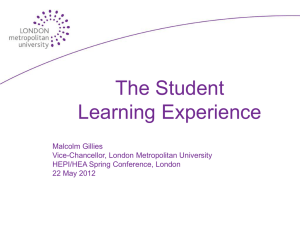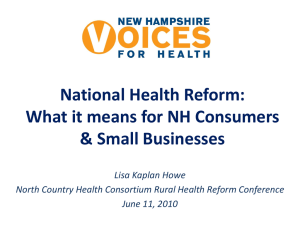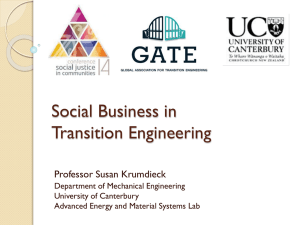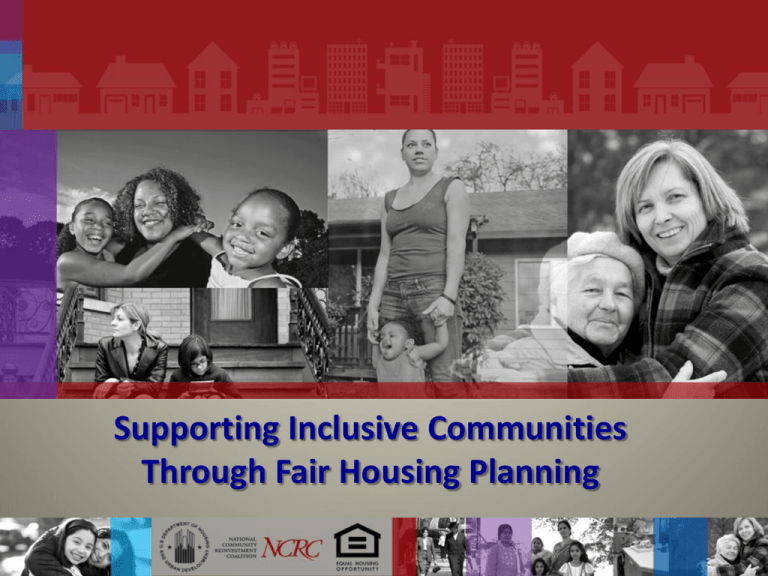
Supporting Inclusive Communities
Through Fair Housing Planning
Shaun Donovan
Secretary, United States Department of Housing & Urban Development
"With the passage of the Fair Housing Act in 1968, we acknowledged
that segregation didn't happen in spite of government policy – it
happened in large part because of it…And we affirmed that government
has a role to play in creating integrated, inclusive, diverse communities."
"Our success is measured by whether HUD is increasing the number of
low-poverty, racially diverse communities in America."
- HUD Secretary Shaun Donovan
Why Affirmatively Further Fair
Housing?
"Simple justice requires that public funds, to which all taxpayers of all races contribute, not be spent in any
fashion which encourages, entrenches, subsidizes, or results in racial discrimination. Direct discrimination by
Federal, State, or local governments is prohibited by the Constitution. But indirect discrimination, through
the use of Federal funds, is just as invidious; and it should not be necessary to resort to the courts to prevent
each individual violation.” – John F. Kennedy (1963).
What is Fair Housing Planning?
Planning activities undertaken by local, state, and
regional agencies and governing bodies to eradicate
and prevent discrimination and segregation within and
through its actions, policies, investments, and
programs; including those of the public and private
sectors.
What is Fair Housing Planning?
It is not limited to Housing and Community
Development matters but includes all disciplines
that directly and indirectly connect to rental, real
estate, advertising, home insurance, lending and
land use, as well as siting of affordable housing, and
the public and private services that are available to a
community, including education, transportation, and
health.
What is Fair Housing Planning?
“Where the community planning and development
perspective looks directly at needs for housing and
possible barriers to meeting those needs, the fair
housing perspective focuses as much on the causes of
needs of groups or persons protected by the Fair
Housing Act as it does on the needs themselves.”
HUD’s Fair Housing Planning Guide Chapter 2 Preparing for Fair Housing Planning, p. 2-20
Affirmatively Furthering Fair Housing
Statute
42 U.S.C. 3608 (e)(5)
(e) Functions of Secretary
The Secretary of Housing and Urban Development shall—
(5) administer the programs and activities relating to
housing and urban development in a manner
affirmatively to further the policies of this subchapter;
7
RESPONSIBILITIES FOR
METROWIDE/REGIONAL FAIR
HOUSING PLANNING
Metrowide and Regional (Consortium of Localities) jurisdictions must follow three
components of Fair Housing Planning:
1.
2.
3.
The Analysis of Impediments
The actions to be taken to address the impediments
The maintenance of records
In addition to these requirements, Metrowide/Regional jurisdictions have a dual
responsibility as it relates to Fair Housing Planning:
a.
b.
Must include an analysis that identifies both State & Entitlement jurisdictional
and regional impediments to fair housing choice and the appropriate actions to
remove them
A key aspect of metrowide/regional fair housing planning is the creation of a
centralized and consolidated applicant database for all assisted housing
programs operating in the metropolitan/regional area which can be
metro/regionally administered
What is an “Impediment” to Fair
Housing Choice?
• Impediments to fair housing choice are
defined as:
Any actions, omissions, or decisions taken because of race, color,
religion, sex, disability, familial status, or national origin that restrict
housing choices or the availability of housing choice
Any actions, omissions, or decisions that have this effect.
Getting Started: What Should Be
Included/Addressed in an Analysis of
Impediments?
HMDA ( Home Mortgage
Disclosure Act) Data
Fair Housing
Investigation, Testing &
Relevant Research
Results
Demographic patterns
supported by meaningful
graphs & maps
Fair housing complaints,
public and private sector
litigation, and other data
that may impact upon
the jurisdiction’s
achievement of fair
housing choice
Zoning and land use
policies
Results of Fair Housing
Initiatives (FHIP) grants
Components
of an
Effective AI
Patterns of Occupancy
Recommendations
✔-List: What Barriers to Housing
Choice Are You Looking For?
Problems faced by immigrants, emerging populations and minorities in search of affordable housing
Lack of affordable housing
LGBT Issues
Housing problems created by the presence of lead-based paint in older dwellings
Problems faced by Section 8 certificate and voucher holders trying to exercise housing choice in a metropolitan area – Source of Income
Building, safety, health, and occupancy codes
Community development and housing authority policies
Appraisal laws and regulations
Creation of jobs and training programs
Advisory boards, commissions, planning boards and committees
Funding and finance mechanisms
Site Selection Criteria
NIMBYism
Accessibility design and new construction
Advertising
✔-List: “What Are You Looking For?”
Lending and property insurance practices
Problems faced by African Americans and Hispanics securing mortgage loans
Problems associated with providing housing choice to people with disabilities
Tax laws
Zoning codes
Banking and insurance laws and regulations
Public transportation
Quality of Municipal services
Interdepartmental cooperation to promote integration
Quality of municipal services
Activities that may displace tenants
Policies and procedures of financial institutions
Rental and sales practices
Issues identified by FHIP programs
Employment, social services, and access to transportation
SEGREGATION
Role of federal, state and local
governments in creating segregation
Slavery
Black codes
Jim crow laws
Racial zoning
Redlining
What Happens When Poor People are
Concentrated Together?
Three-quarters of AfricanAmericans live in highly segregated
neighborhoods today, whereas 90100% of other groups experience
only moderate levels of
segregation.
Massey, Douglas S. and Mary J. Fischer. 2000. “How
Segregation Concentrates Poverty.” Ethnic and Racial
Studies 23(4): 670-691.
Impact of Segregation
• Concentration of existing affordable housing in central cities and older
suburbs perpetuates the isolation of low-income residents and people of
color from life opportunities available to suburban residents.
• One result is to reinforce the racial segregation, which is intimately related
to the concentration of poverty in urban core areas and in older, inner-ring
suburbs
• Racial and ethnic segregation in effect also concentrates poverty because
of income gaps
• In today’s world, poverty and racial and ethnic segregation are linked and
the face of poverty is also the face of segregation
When Segregation and Poverty Occur
Together
• Loss of businesses: grocery
stores, banks, etc.
• Loss of political power:
environmental discrimination
(waste processing facilities and
chemical plants)
• Lower property values:
deteriorating buildings and and
unsavory facilities (jails)
• Loss of medical facilities and
clinics
• Loss of revenue for public schools
Massey, Douglas S. 1990. “American
Apartheid: Segregation and the Making of
the Underclass. American Journal of
Sociology 96(2): 329-357
Impact of Segregation cont.
•
•
•
•
•
•
•
•
Poor housing
Substandard schools
Higher unemployment
Inadequate transportation
Higher crime
Health care issues
Diminished social capital
Declining home equity
Segregation Empowers Discrimination
•
•
•
•
•
•
•
•
•
•
•
•
•
Steering
Blockbusting
Redlining
Predatory Lending
Equity Stripping
Discriminatory advertisements
NIMBYism
Community Disinvestment
Gentrification
Exclusionary zoning – NAACP vs. Town of Huntington
Code enforcement
Provision of municipal services
Environmental racism
Does Your Community Have
Segregation Challenges?
One data piece that can be used to help answer this question is the
“Dissimilarity Index”
• Metro/Micro level statistic that builds up from tract‐level (“neighborhood level”)
data
• Used to summarize segregation or integration of two groups
• Index can take on a value from zero (0) to one (1), with zero representing complete
integration and one representing complete segregation
• Can be loosely interpreted as the percentage of one group that would need to
move in order for each tract to match the composition of the area
What are the Trends of
Populations in These Areas?
• Increase or decrease of populations in racially and ethnically concentrated
areas of poverty since 1940 is useful to show trends. Go to
http://www.s4.brown.edu/us2010/
• and click on MAP USA
Information for slide provided by HUD’s “Regional Fair Housing Equity Assessment” (Aug. 2011)
Summary
• Once the racially and ethnically concentrated areas
of poverty have been assessed, the necessary steps
must be taken to identify and ameliorate the gaps
in infrastructure and housing to encourage diversity
and promote equal and fair access to housing,
banking services, reputable education systems,
transportation, etc.
Investing in
Communities
A: Ivy City, Washington DC
Crummell School
.
B: Ivy City, Washington DC
Crummell School
.
C: Ivy City, Washington DC
Crummell School
.
A: Ivy City, Washington DC
Capitol Avenue
.
B: Ivy City, Washington DC
Capitol Avenue
.
C: Ivy City, Washington DC
Capitol Avenue
.
D: Ivy City, Washington DC
Capitol Avenue
.
E: Ivy City, Washington DC
Capitol Avenue
.
A: Trinidad, Washington DC
Orren Street
.
B: Trinidad, Washington DC
Orren Street
.
C: Trinidad, Washington DC
Orren Street
.
D: Trinidad, Washington DC
Orren Street
.
E: Trinidad, Washington DC
Orren Street
.
F: Trinidad, Washington DC
Orren Street
.
G: Trinidad, Washington DC
Orren Street
.
B: Trinidad, Washington DC
Bladensburg Road
.
C: Trinidad, Washington DC
Bladensburg Road
.
D: Trinidad, Washington DC
Bladensburg Road
.
E: Trinidad, Washington DC
Bladensburg Road
.
F: Trinidad, Washington DC
Bladensburg Road
.
ACCESS TO OPPORTUNITY
Access to Opportunity
• Opportunity areas have:
Access more integrated setting – ROC, HCV, RAD
Access to better than average schools
Access to jobs, especially entry level
Access to transportation options – Metro & RTA
Access to health care services
Are not areas of concentrated poverty
Are often not areas that are already integrated – Isolation
(segregation)
Information for slide provided by HUD’s “Regional Fair Housing Equity
Assessment” (Aug. 2011)
For Each Area of Opportunity
• Identify elements of opportunity
Better than average schools
Jobs, especially entry level
Health care access
Commercial/retail access
Access to effective transportation
Relatively low crime rate
Availability of infrastructure
Recreational areas
Libraries
Information for slide provided by HUD’s “Regional Fair Housing Equity
Assessment” (Aug. 2011)
For Each Area of Opportunity
• Identify areas where affordable housing options are lacking
Examine existing affordable housing options and location
Examine availability of Section 8 units in area
Examine availability of accessible housing in area
Examine availability of housing for homeless persons
Availability of housing for persons with disabilities
• Supportive housing
• Other
Information for slide provided by HUD’s “Regional Fair Housing Equity Assessment” (Aug. 2011)
Limited English Proficiency
• Are LEP individuals significantly represented? (more than 1000, greater
than 5% of eligible population)
• What are the barriers to access to government services and housing for
persons with LEP?
• For each participant and each sub recipient, describe existing policies
and outreach to reach relevant LEP populations
• Describe ability to provide interpreters
• Describe ability to provide written translations
Information for slide provided by HUD’s “Regional Fair Housing Equity Assessment” (Aug. 2011)
Creating Linkages to Areas of
Opportunity
• Special issues to think about:
Affirmative marketing
Transportation needs of different populations
Access to services
Mobility counseling
Potential need for community supports and networks
• Sustained connection to new communities
Information for slide provided by HUD’s “Regional Fair Housing Equity Assessment” (Aug. 2011)
Affirmative Marketing cont.
Census data indicates that certain areas have been racial
isolated for decades, containing high white populations.
Potential AI Recommendation:
The jurisdiction needs to increase its efforts to affirmatively market housing
opportunities to people who are underrepresented in housing assistance
programs.
Access for Families with Children
• Identify housing needs of families with
children
Units with more than two bedrooms
Access to schools
Access to public transportation
Access to nearby entry level jobs
Information for slide provided by HUD’s “Regional Fair Housing Equity Assessment” (Aug. 2011)
Strategies for Promoting
Mixed-Income Housing
•
•
•
•
•
•
•
•
Limited Equity Cooperatives
Inclusionary Zoning
Mixed-Use Zoning
Mutual Housing
Land Trusts
Turn-Key Programs
Foreclosure Conversion
In-Law Apartments
Affirmatively
Furthering Fair
Housing for Lenders
Do Lending Institutions Have a
Responsibility to AFFH?
Lending institutions have an AFFH responsibility
because their prudential regulators have AFFH
obligations under the Fair Housing Act of 1968, as
amended, Title VI of the 1964 Civil Rights Act, the
Community Reinvestment Act and Executive Order
12892.
Do Lending Institutions Have a
Responsibility to AFFH? (cont.)
Executive Order 12892
LEADERSHIP AND COORDINATION OF FAIR HOUSING IN FEDERAL
PROGRAMS: AFFIRMATIVELY FURTHERING FAIR HOUSING
Section 1. Administration of Programs and Activities Relating to Housing
and Urban Development. 1-101. Section 808(d) of the Act, as amended,
provides that all executive departments and agencies shall administer
their programs and activities relating to housing and urban
development (including any Federal agency having regulatory or
supervisory authority over financial institutions) in a manner
affirmatively to further the purposes of the Act and shall cooperate
with the Secretary of Housing and Urban Development to further such
purposes. 1-102.
Do Lending Institutions Have a
Responsibility to AFFH? (cont.)
Executive Order 12892 (Continued)
LEADERSHIP AND COORDINATION OF FAIR HOUSING IN FEDERAL
PROGRAMS: AFFIRMATIVELY FURTHERING FAIR HOUSING
As used in this order, the phrase programs and activities shall include
programs and activities operated, administered, or undertaken by the
Federal Government; grants; loans; contracts; insurance; guarantees;
and Federal supervision or exercise of regulatory responsibility
(including regulatory or supervisory authority over financial
institutions).
What Makes for a Healthy
Community?
Schools
Real Estate
Revenue
Jobs
Credit and
Capital
Police & Fire
Environment
Lending Discrimination
Infrastructure
Infrastructure
Where once you had a prosperous, functional community, it now
becomes dysfunctional.
Commerce
Commerce
Jobs
Jobs
Health
HealthCare
Care
Real
Real Estate
Estate
Schools
Schools
Revenue
Revenue
Police
Police &
&Fire
Fire
Environment
Environment
Madison, WI: Inclusionary Zoning Ordinance (IZ)
Adopted in January 2004, the Inclusionary Zoning
Ordinance (IZ) requires 15% of the dwelling units
within new residential projects to be affordable
to households at certain income levels. The
program was expected to create approximately
200-300 affordable units per year. During the first
year of the program, sixteen projects were
reviewed and approved and 311 or 15.7% were
affordable.
Mt. Laurel, NJ: Ethel R. Lawrence Homes
Ethel R. Lawrence Homes is an award-winning
affordable rental apartment-housing complex
located in upscale Mount Laurel Township,
about 30 minutes from downtown
Philadelphia. The development, which boasts
spacious one-bedroom, two-bedroom and
three-bedroom units on 62 attractively
landscaped acres, has long been recognized for
setting the gold standard for affordable
housing in communities of opportunity.
East Greenwich, RI: Cottages on Greene
Cottages on Greene is a privately financed infill development
composed of mixed income housing located in the historic
downtown of East Greenwich, Rhode Island. Prior to
construction, Cottages on Greene’s nearly one-acre site had
sat derelict for several years. In early 2009, as the recession
slowed development, a team led by 620 Main Street
Associates responded by providing a project concept that
leveraged the site’s walk-able location and an emerging
demand for scaled-down, urban-style living. As a 15-unit
“cottage” development, a style influenced by the preserved
cottage on the site, Cottages on Greene has contributed five
deed-restricted units to the community’s supply of affordable
housing. The Congress for the New Urbanism awarded the
project an Honorable Mention in its 2011 Charter Awards
program, which recognizes projects for excellence in walk-able
and sustainable design.1 Completed in November 2010,
Cottages on Greene demonstrates how innovative housing
solutions can succeed, even in challenging economic times.
Lemoore, CA: Montgomery Crossing Apartments
Montgomery Crossing is a new construction
development of 57 rental units, located in Kings
County, CA. The site has a mix of two, three, and
four bedroom units for low-income residents. It is
partially financed by the USDA-RD Section 515
loan program and the Section 538 Guaranteed
Rural Rental Housing Program (GRRHP). The
development design features two-story gardenstyle apartment buildings, with unit plans
thoughtfully laid out for family interaction.
Bay Area, CA: Bay Area Transit-Oriented Affordable
Housing Fund
The $50 million Bay Area Transit-Oriented
Affordable Housing (TOAH) Fund provides
financing for the development of affordable
housing and other vial community services near
transit lines throughout the Bay Area. Through
the Fund, developers can access flexible,
affordable capital to purchase or improve
available property near transit line for the
development of affordable housing, retail space
and other critical services, such as child care
centers, fresh food outlets and health clinics.
Montgomery County, MD: Moderately Priced Dwelling
Unit Ordinance
Enacted in 1974, the county’s Moderately
Priced Dwelling Unit (MPDU) Ordinance
requires developers of 20 or more units to
make 12.5% to 15% of the new units
affordable to lower income households. In
exchange for the affordable units, developers
are granted a 22% density bonus. Since the
inception of the ordinance in 1976, more than
11,800 affordable units have been developed.
Diversity: Oak Park, IL
“The people of Oak Park choose this community, not just as a place to live, but as a way of life…Ours is a
dynamic community that encourages the contributions of all citizens, regardless of race, gender, age,
ethnicity, sexual orientation, disability, religion, economic status, political affiliation or any of the other
distinguishing characteristics that all too often divide people in society.”
~Oak Park Diversity Statement
The Village of Oak Park passed a fair housing ordinance in 1968 (in the same year as the federal Fair Housing
Act) to ensure equal access to housing in the community. In 1972 the Oak Park Housing Center was founded
by Roberta (Bobbie) Raymond to promote integration in the community by ensuring equal access and
discouraging white flight.
Diversity: Columbia, MD
“It is important for all of us who are selling houses or renting apartments in Columbia to understand that
Columbia is truly an open city. . .Simply stated, we are color-blind.”
- Jim Rouse, Columbia, MD Planner
Columbia, Maryland is a planned community that consists of ten self-contained villages, located in Howard County,
Maryland. The village concept is aimed to provide Columbia a small-town feel. Each village comprises several
neighborhoods, with the village center containing both middle and high schools. All villages have a shopping center,
recreational facilities, a community center, a system of bike/walking paths, and homes. Four of the villages have
interfaith centers. Most of Columbia’s neighborhoods contain single-family homes, townhomes, condominiums and
apartments. The original plan for the community, would have had all the children of a neighborhood attend the same
school, melding neighborhoods into a community and ensuring that all of Columbia’s children would get the same
high-quality education.
Failure to conduct an open and inclusive AI that incorporates and/or that
acknowledges public and private sector stakeholder and community concerns
and pertinent issues
Potential AI Recommendations
The AI structure should contain all elements of the community’s makeup with clear and continuous
exchange of concerns, ideas, analysis, and evaluation of results.
Best practices include convening public meetings with neighborhood, not for profit, and private sector
and industry leaders on issues such as increasing housing choice, demographic patterns, housing profile
and community needs, Home Mortgage Disclosure Act Data, testing results, and inventory of accessible
housing units for persons with disabilities. Many jurisdictions are also taking advantage of emerging
technologies available on the Internet to disseminate information and promote public comment and
discussion.
SOURCE: HUD Fair Housing Planning Guide
Failure to plan and implement qualified action(s) on an annual basis (by
program year) to address impediments to fair housing choice with the
grantee’s jurisdiction
Potential AI Recommendation
Once an action plan is identified, it is critical that jurisdictions report out on progress and impediments
to realizing the identified goals. Sometimes, community concerns surrounding an AI may emerge that are
counterproductive to fair housing choice, such as 1) community resistance when minorities, persons with
disabilities and/or low-income persons first move into white and/or moderate to high income areas or 2)
when housing for these residents are sited in a manner that will not promote integration, or in the
alternate, 3) when local ordinances have the effect of restricting housing opportunities in violation of the
Fair Housing Act.
A wide variety of activities can address these concerns, ranging from education and outreach activities
geared for the general public to technical training for industry representatives and organizations;
Enforcement of fair housing laws, counseling, fair housing audits, and incentives to create expanded
housing opportunity and mobility with the jurisdiction. Jurisdictions can even set-up or designate a
commission that will work with stakeholders to develop and report on action plans.
SOURCE: HUD Fair Housing Planning Guide
Limits on unrelated people residing together
Potential AI Recommendation:
The jurisdiction should add a provision to its zoning ordinance explicitly
permitting unrelated individuals to live together under the same rules that
apply to a family, as a reasonable accommodation. Zoning officers should be
vested with the authority to grant such reasonable accommodations.
Occupancy limits
Potential AI Recommendation:
Occupancy limits should be brought into conformance with the state health
code.
SOURCE: HUD Fair Housing Planning Guide
Lack of training for municipal staff on fair housing issues
Potential AI Recommendation:
Design and implement a fair housing training program. Fair housing non-profit
organizations can assist with this effort.
SOURCE: HUD Fair Housing Planning Guide
CONCLUSION
• Thank you for participating!
• Should you have additional questions or
concerns please contact NCRC at:
727 15th Street NW, Suite 900
Washington, DC 20005
PHONE: 202-628-8866
FAX: 202-628-9800


